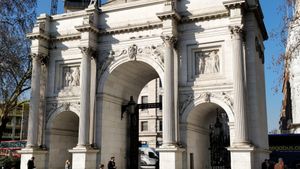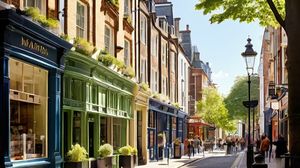
The Tyburn Tree Marker at Marble Arch in London marks the site of Tyburn, a notable spot in the city's history known for being a place of execution from as early as the 12th century until the late 18th century. Situated near what is now Marble Arch, the Tyburn Tree was not a tree at all, but rather a triangular gallows used to simultaneously hang multiple people.
The first executions at Tyburn were conducted in 1196, and the site continued to serve this grim purpose until 1783. It became infamous as a theatre of public spectacle, drawing large crowds who gathered to witness the executions. These events were so popular that people would rent out windows with good views or even construct temporary stands.
One of the most unique features of the Tyburn gallows was its triangular shape, allowing up to 24 individuals to be executed at once. This efficiency was matched by the morbid banality with which public executions were treated as forms of entertainment, including tales of execution-bound criminals providing last-minute speeches.
The phrase "going west" originated from Tyburn executions, as condemned prisoners were transported from Newgate Prison in central London to this location, which is situated to the west of the city. This journey became a symbolic and literal final passage for many.
Among the most notable individuals executed at Tyburn was Oliver Cromwell. Although already deceased, his body was exhumed and ritually "executed" in a posthumous mock execution ordered by King Charles II in a striking act of posthumous retribution.
Today, the actual site of the Tyburn Tree is marked by a plaque near Marble Arch, giving visitors an opportunity to reflect on the profound historical significance and stark contrast between the bustling city of today and the darker chapters of its past.

Making the Most of Your Visit:
When visiting the Tyburn Tree Marker at Marble Arch, take a moment to appreciate its juxtaposition against the backdrop of bustling traffic, modern retail, and Hyde Park. It offers a rare glimpse into the city's past amidst its vibrant present.
Visit in the early morning or late afternoon for a quieter experience and to capture some intriguing photos with diverse lighting. The area can get quite busy during the day.
If you're fascinated by the history of public execution sites, consider bringing along a printout or digital guide of some significant events and individuals related to Tyburn, like the executions of "The Tyburn Martyrs," to enrich your visit.
Standing by the marker, take a moment to imagine the journey west from Newgate Prison. This exercise can add a layer of context to your experience, helping to frame the location in a historical light that's often overlooked.
Just across the road, you'll find Speaker's Corner in Hyde Park. After visiting the marker, it's interesting to contrast the historical significance of public executions with modern practices of public speech and freedom of expression.

Visiting Times & Costs:
The Tyburn Tree Marker at Marble Arch is always open to the public, as it is an outdoor historical marker located near a busy intersection. There are no entrance fees or charges associated with visiting the marker, making it a free point of interest for all.
As the marker is part of a public space, there are generally no specific accessibility barriers, but it's important to note the surrounding area's busy traffic and potentially uneven pavements, which may pose challenges for some visitors. However, there are pedestrian crossings and pathways to help facilitate safer access.
Visitors should exercise caution when navigating the area due to the busy roads.

Address & Map:

Nearby:























